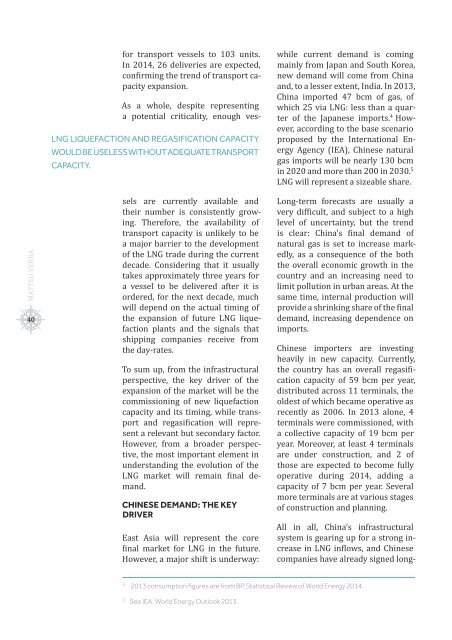You also want an ePaper? Increase the reach of your titles
YUMPU automatically turns print PDFs into web optimized ePapers that Google loves.
MATTEO VERDA<br />
40<br />
for transport vessels to 103 units.<br />
In <strong>2014</strong>, 26 deliveries are expected,<br />
confirming the trend of transport capacity<br />
expansion.<br />
LNG LIQUEFACTION AND REGASIFICATION CAPACITY<br />
WOULD BE USELESS WITHOUT ADEQUATE TRANSPORT<br />
CAPACITY.<br />
As a whole, despite representing<br />
a potential criticality, enough vessels<br />
are currently available and<br />
their number is consistently growing.<br />
Therefore, the availability of<br />
transport capacity is unlikely to be<br />
a major barrier to the development<br />
of the LNG trade during the current<br />
decade. Considering that it usually<br />
takes approximately three years for<br />
a vessel to be delivered after it is<br />
ordered, for the next decade, much<br />
will depend on the actual timing of<br />
the expansion of future LNG liquefaction<br />
plants and the signals that<br />
shipping companies receive from<br />
the day-rates.<br />
To sum up, from the infrastructural<br />
perspective, the key driver of the<br />
expansion of the market will be the<br />
commissioning of new liquefaction<br />
capacity and its timing, while transport<br />
and regasification will represent<br />
a relevant but secondary factor.<br />
However, from a broader perspective,<br />
the most important element in<br />
understanding the evolution of the<br />
LNG market will remain final demand.<br />
CHINESE DEMAND: THE KEY<br />
DRIVER<br />
East Asia will represent the core<br />
final market for LNG in the future.<br />
However, a major shift is underway:<br />
while current demand is coming<br />
mainly from Japan and South Korea,<br />
new demand will come from China<br />
and, to a lesser extent, India. In 2013,<br />
China imported 47 bcm of gas, of<br />
which 25 via LNG: less than a quarter<br />
of the Japanese imports. 4 However,<br />
according to the base scenario<br />
proposed by the International Energy<br />
Agency (IEA), Chinese natural<br />
gas imports will be nearly 130 bcm<br />
in 2020 and more than 200 in 2030. 5<br />
LNG will represent a sizeable share.<br />
Long-term forecasts are usually a<br />
very difficult, and subject to a high<br />
level of uncertainty, but the trend<br />
is clear: China’s final demand of<br />
natural gas is set to increase markedly,<br />
as a consequence of the both<br />
the overall economic growth in the<br />
country and an increasing need to<br />
limit pollution in urban areas. At the<br />
same time, internal production will<br />
provide a shrinking share of the final<br />
demand, increasing dependence on<br />
imports.<br />
Chinese importers are investing<br />
heavily in new capacity. Currently,<br />
the country has an overall regasification<br />
capacity of 59 bcm per year,<br />
distributed across 11 terminals, the<br />
oldest of which became operative as<br />
recently as 2006. In 2013 alone, 4<br />
terminals were commissioned, with<br />
a collective capacity of 19 bcm per<br />
year. Moreover, at least 4 terminals<br />
are under construction, and 2 of<br />
those are expected to become fully<br />
operative during <strong>2014</strong>, adding a<br />
capacity of 7 bcm per year. Several<br />
more terminals are at various stages<br />
of construction and planning.<br />
All in all, China’s infrastructural<br />
system is gearing up for a strong increase<br />
in LNG inflows, and Chinese<br />
companies have already signed long-<br />
4.<br />
2013 consumption figures are from BP, Statistical Review of World Energy <strong>2014</strong>.<br />
5.<br />
See IEA, World Energy Outlook 2013.










